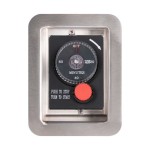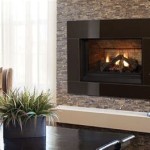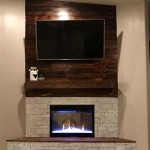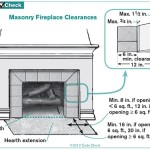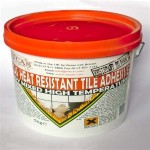Natural Stone Fireplace Ideas: A Guide to Timeless Elegance and Warmth
Natural stone fireplaces have long been a centerpiece of homes, offering both aesthetic appeal and functional warmth. The inherent beauty and durability of natural stone create a sense of permanence and luxury that is difficult to replicate with other materials. The options for design and application are vast, ranging from rustic, stacked stone arrangements to sleek, modern installations. This article explores various natural stone fireplace ideas, highlighting the characteristics of different stone types and their suitability for diverse architectural styles.
Selecting the right natural stone for a fireplace involves considering several factors, including cost, aesthetic preference, material properties, and installation feasibility. The chosen stone should complement the existing décor and architectural style of the room, creating a cohesive and harmonious environment. Furthermore, it's essential to understand the specific characteristics of each stone type, such as its porosity, density, and heat resistance, to ensure its longevity and safety.
Choosing the Right Natural Stone: A Comparative Analysis
The selection of natural stone is the cornerstone of a successful fireplace design. Several popular options exist, each with distinct visual and physical properties.
Limestone: Limestone is a sedimentary rock prized for its soft, earthy tones and relatively uniform texture. Its neutral color palette, typically ranging from cream to light gray, makes it highly versatile and easily integrates with various interior design schemes. Limestone is relatively soft compared to other stones, making it easier to cut and shape during installation. However, its porous nature requires sealing to prevent staining and water damage. Limestone fireplaces are well-suited for both traditional and contemporary settings, offering a classic and refined aesthetic.
Granite: Granite is an igneous rock known for its exceptional durability and distinctive speckled appearance. Its wide range of colors, from deep blacks and reds to light grays and whites, provides numerous design possibilities. Granite is highly resistant to heat, scratches, and stains, making it an ideal choice for high-traffic areas and fireplaces. Due to its hardness, granite requires specialized tools and expertise for cutting and installation. A granite fireplace can add a touch of sophistication and elegance to any room, particularly modern and transitional designs.
Marble: Marble is a metamorphic rock celebrated for its luxurious veining and polished surface. Its elegant aesthetic and wide range of colors, including white, black, and various shades of gray, green, and pink, make it a popular choice for high-end homes. Marble is relatively soft and porous, requiring sealing and careful maintenance to prevent staining and etching. While marble’s heat resistance is sufficient for fireplace surrounds, it's generally not recommended for areas directly exposed to flames. Marble fireplaces exude sophistication and timeless beauty, complementing both classic and contemporary designs.
Slate: Slate is a fine-grained metamorphic rock known for its distinctive layered appearance and natural cleft surface. Its dark, often muted colors, such as gray, black, and green, create a rustic and earthy aesthetic. Slate is highly durable and resistant to heat, water, and staining, making it a practical choice for fireplaces. Its natural texture adds visual interest and depth to the design. Slate fireplaces are particularly well-suited for rustic, contemporary, and industrial-style homes.
Fieldstone: Fieldstone refers to naturally occurring stones collected from fields and riverbeds. These stones typically have irregular shapes and sizes, lending a rustic and organic aesthetic to the fireplace. Fieldstone can vary widely in color and texture, depending on its geological origin. Its rugged appearance makes it ideal for creating a cozy and inviting atmosphere in cabins, lodges, and homes with a rustic or farmhouse aesthetic. Installation of fieldstone requires careful planning and skilled craftsmanship to ensure structural stability and visual appeal.
Design Considerations for Natural Stone Fireplaces
Beyond the choice of stone, several design aspects influence the overall look and feel of a natural stone fireplace.
Style and Proportion: The fireplace style should complement the overall architectural style of the home. In a traditional home, a grand, ornate fireplace with intricate carvings might be appropriate, while a modern home might benefit from a minimalist design with clean lines and a sleek stone finish. The proportion of the fireplace to the room is also crucial. A fireplace that is too large can overwhelm the space, while one that is too small can appear insignificant. Carefully consider the dimensions of the room and the surrounding furniture when determining the size of the fireplace.
Mantels and Surrounds: The mantel and surrounding elements play a significant role in defining the style and character of the fireplace. A wooden mantel can add warmth and a touch of traditional elegance, while a stone mantel can create a more modern and minimalist look. The surround, which is the area immediately surrounding the firebox, can be clad in the same stone as the rest of the fireplace or in a contrasting material for visual interest. Consider incorporating architectural details, such as columns, arches, or corbels, to enhance the overall design.
Stone Arrangement and Texture: The way the stone is arranged and its texture can significantly impact the aesthetic of the fireplace. Stacked stone, where individual stones are arranged in a horizontal or vertical pattern, creates a rustic and textured look. Dry-stacked stone, where the stones are fitted together without mortar, adds to the natural and rugged appeal. For a more refined look, consider using large slabs of stone with minimal grout lines. The texture of the stone itself can also vary from smooth and polished to rough and textured, depending on the stone type and finish.
Color Palette and Lighting: The color palette of the fireplace should complement the surrounding décor. Neutral tones, such as beige, gray, and white, are versatile and easily integrate with various color schemes. For a more dramatic look, consider using darker stones, such as black granite or slate. Lighting can also enhance the beauty of the fireplace. Recessed lighting can highlight the texture and color of the stone, while a decorative sconce can add a touch of elegance. Ensure that the lighting is appropriately positioned to avoid glare and create a warm and inviting ambiance.
Installation and Maintenance Considerations
Proper installation and ongoing maintenance are crucial for ensuring the longevity and safety of a natural stone fireplace.
Professional Installation: Installing a natural stone fireplace is a complex process that requires specialized skills and knowledge. It is highly recommended to hire a qualified and experienced contractor to ensure that the fireplace is installed correctly and safely. The contractor should have expertise in working with various stone types and be familiar with local building codes and regulations. A properly installed fireplace will not only look aesthetically pleasing but also function efficiently and safely.
Sealing and Waterproofing: Many natural stones, particularly limestone and marble, are porous and susceptible to staining and water damage. Sealing the stone is essential to protect it from spills, dirt, and moisture. Use a high-quality sealant specifically designed for natural stone. The sealant should be applied according to the manufacturer's instructions and reapplied periodically as needed. In areas prone to water exposure, such as the hearth, consider using a waterproof membrane to prevent water penetration.
Cleaning and Maintenance: Regular cleaning and maintenance are essential for preserving the beauty and longevity of a natural stone fireplace. Avoid using harsh chemicals or abrasive cleaners, as these can damage the stone's surface. Instead, use a mild soap and water solution to clean the stone. Wipe up spills immediately to prevent staining. Regularly inspect the fireplace for cracks or damage and repair them promptly to prevent further deterioration. If necessary, hire a professional stone restoration company to clean and repair the fireplace.
Fire Safety: Fire safety is paramount when operating a fireplace. Ensure that the chimney is properly cleaned and inspected annually to prevent creosote buildup, which can cause chimney fires. Keep flammable materials, such as curtains, rugs, and furniture, away from the fireplace. Always use a fireplace screen to prevent sparks from escaping and causing a fire. Never leave a fire unattended. Follow all safety guidelines provided by the fireplace manufacturer and local fire authorities.
By carefully considering these factors, homeowners can create a stunning and functional natural stone fireplace that will enhance the beauty and value of their homes for years to come. The inherent beauty and durability of natural stone ensure that a well-designed and properly maintained fireplace will remain a cherished centerpiece for generations.

25 Stone Fireplace Ideas For A Cozy Nature Inspired Home Surround Country

Natural Stacked Stone Veneer Fireplace Ideas

50 Sensational Stone Fireplaces To Warm Your Senses

Best Stone Fireplace Ideas

50 Sensational Stone Fireplaces To Warm Your Senses

27 Modern Stone Veneer Fireplace Ideas Stoneyard
:strip_icc()/Screenshot2021-10-19at09-16-46Portfolio-AmyBartlamPhotography-1f35ea9ec29846779a2d62b42676eff9.png?strip=all)
20 Best Stone Fireplace Ideas

4 Natural Stacked Stone Fireplaces For Your Dream Design

Best Stone Fireplace Ideas

Stone Veneer Fireplaces Natural Facing

